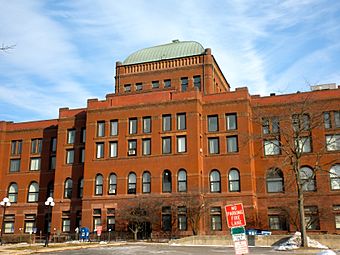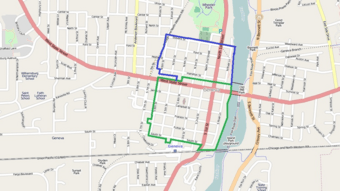Central Geneva Historic District facts for kids
|
Central Geneva Historic District
|
|

Kane County Courthouse in the district
|
|

Location of the Central Geneva Historic District (green outline) within Geneva. The adjacent North Geneva Historic District is outlined in blue to the north.
|
|
| Location | Roughly bounded by Fox River, South, 6th and W. State Sts., Geneva, Illinois |
|---|---|
| Area | 67 acres (27 ha) |
| Architectural style | Greek Revival, Italianate, Classical Revival |
| NRHP reference No. | 79000845 (original) 16000897 (increase) |
Quick facts for kids Significant dates |
|
| Added to NRHP | September 10, 1979 |
| Boundary increase | July 10, 2017 |
The Central Geneva Historic District is a special area in Geneva, Illinois. It has 102 buildings and structures. Many of these, 68 to be exact, are important because they show the history of the area. This district is in the southern part of Geneva, just south of a road called Illinois Route 38.
Some famous buildings here include the Kane County Courthouse. Another is the P. D. Hoyt House, which was designed by the famous architect Frank Lloyd Wright. This historic district was added to the National Register of Historic Places in 1979. It was made even bigger in 2017.
History of the Central Geneva District
The Central Geneva Historic District covers land from the very first settlement of Geneva. This area is now the southern part of the town. It is mostly a place where people live, with many homes.
However, there is also a shopping area along W. State Street (Illinois Route 38). Important public buildings are also found here. These include a public library, the city hall, and the county courthouse. Another main road in the district is S. First Street (Illinois Route 31).
Most of the houses are two stories tall and made of wood. They were built between 1840 and 1900. Many have a simple, local style called vernacular architecture. Geneva is known as a nice place to shop. This encouraged the city to fix up many old buildings. The district officially became part of the National Register of Historic Places on September 10, 1979.
Special Buildings in the District
The people who nominated this area as a historic district pointed out several buildings. These buildings are great examples of how architecture looked in the mid-to-late 1800s.
Here are some of the notable properties:
- Unitarian Church: Built in 1843, this church shows the Greek Revival style.
- Loveday House: This home was built around 1869. It features the Gothic Revival style.
- Augustus Herrington House: Built around 1851, this house is in the Italianate style.
- Moore House #2: This Italianate style house was built in 1864.
- Plato House: Another Italianate style home, built in 1857.
- Charles B. Wells House: Built in 1850, this house is in the Neoclassical style.
- George Patten House: This home from 1857 shows the Federal Revival style.
- Isaac Wilson House #1: Built around 1852, it also has a Federal Revival look.
- P. D. Hoyt House: This house was built in 1906. It was designed by the famous architect Frank Lloyd Wright and is in the Prairie School style.
- Eben Conant House: Built around 1844, this house has a simple, local vernacular style.
- Walter House: Another vernacular style home, built around 1855.
- Benjamin Wilson house: This house was built around 1848.


